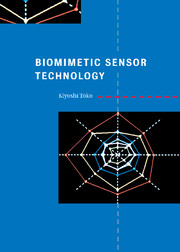3 - Biomimetic membrane devices
Published online by Cambridge University Press: 23 October 2009
Summary
This chapter describes biomimetic membrane devices, which were developed by utilizing a self-assembled characteristic of biomolecules. First, some typical self-organized phenomena such as rhythm and pattern formation are described, because biomimetic membrane devices work far from equilibrium. It is shown that lipid membranes can show action potential, which is a transient all-or-non change of membrane potential elicited under nonequilibrium conditions with applied stimuli such as an electric current, i.e., this membrane can be regarded as an excitable model membrane or an artificial nerve membrane similar to natural nerve membranes. Since the frequency of self-sustained oscillations increases with increasing DC electric current and/or pressure, this membrane is a kind of DC–AC converter made of organic materials, or a chemo-mechanical receptor. It can also be used as a memory element or switching element with analog-to-digital function. Anesthetic substances, local anesthetics and alcohol, can stop the excitation in this biomimetic membrane, which is how anesthesia acts in biological systems. The oscillations are also affected largely by chemical substances producing taste.
Furthermore, this membrane responds to taste substances by changes in membrane electric potential and electric resistance under conditions in which oscillations do not occur. Membranes made of different types of lipid respond to chemicals in different ways. This was the first indication that lipid membranes could be used as transducers to transform taste information to electric signals. Lipid immobilized membranes are a prototype for biomimetic, biomolecular devices to reproduce the sense of taste.
- Type
- Chapter
- Information
- Biomimetic Sensor Technology , pp. 40 - 76Publisher: Cambridge University PressPrint publication year: 2000
- 1
- Cited by



